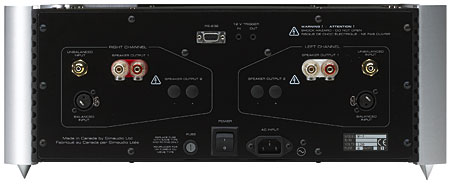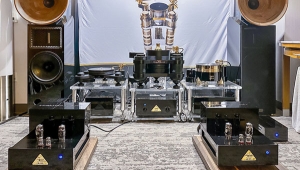| Columns Retired Columns & Blogs |
Simaudio Moon Evolution W-7 power amplifier
When I reviewed the Moon Evolution P-7 preamplifier ($6900) from Canadian manufacturer Simaudio in March 2009, I was impressed by the qualities of both the audio engineering and the sound. It was a no-brainer, therefore, to follow that report with a review of the matching power amplifier, the Moon Evolution W-7. In March 2006 Kalman Rubinson reviewed Simaudio's Moon Evolution W-8, which offered at least 250Wpc into 8 ohms (I measured 310Wpc at clipping). The W-7 looks identical to the W-8, but is 10 lbs lighter, offers 150Wpc into 8 ohms, and retails for $8900 compared with the W-8's $13,500.

The W-7 is a fairly compact amplifier styled to match the P-7, except that the black horizontal ribs along its sides are functional heatsink fins instead of mere decoration. The black front panel is flanked by brushed-aluminum cheeks, and adorned with a central blue LED to indicate that the amplifier is on. Cones screw into the bases of the corner pillars; small metal discs are proved for use by owners who don't want these cones to mark wooden floors. The cones are too short to raise the W-7 above a carpet, which will block the vents on the amplifier's base; I placed the review sample on a wooden board to ensure good ventilation.
The rear panel features mirror-imaged arrays of inputs and outputs: the latter comprise a single pair of brass WBT terminal posts for each channel; the former include, for each channel, a balanced input on an XLR and an unbalanced input on an RCA. When the RCA is used, a jumper is used to tie pin 3 of the XLR jack to ground. The amp is turned on with a rear-panel switch next to the IEC AC jack; a pushbutton below the front-panel LED brings the amplifier out of and back into standby. Simaudio recommends leaving the W-7 powered up at all times.
Inside, the W-7 offers dual-mono construction, starting with a pair of 500VA toroidal power transformers mounted behind the front panel. These feed a total of 115,520µF of reservoir capacitance, the large capacitors mounted on a large, horizontal printed-circuit board with heavy copper planes. Three metal bus bars convey the smoothed ± DC voltage rails and the ground connection from each channel's capacitor bank to its circuit board, these mounted vertically behind the heatsinks. The circuitry is fully balanced, with JFETS used for the input stage and 12 bipolar transistors used for each channel's output, these generously biased to run in class-AB. Simaudio calls the circuit Lynx, their name for a proprietary DC-coupled topology implemented with no overall loop negative feedback. Signal paths are short, and the W-7 is claimed to be unconditionally stable into any load.
Sonics
As with other Simaudio components I have used, the sound of the W-7 was a touch bright and forward when it was first turned on. It began to sound more neutral over the next week or so—I'm told this "break-in" is a function of the heavy, pure-copper circuit-board traces.
Once the W-7 had settled down, it proved a sonic chameleon. Regardless of the type of music played, and without direct reference to another amplifier, the W-7 seemed to impose no identifiable character on the sound—which is, of course, what a power amplifier is supposed to do (or not do). The highs were silky, the midrange smooth and grain-free, but what the W-7 did seem to contribute was an excellent sense of dynamics.
While I had the W-7 in my system, I was mastering a new CD from Bob Reina's jazz quartet, Attention Screen. Due to be released in June on the Stereophile label, this CD features the best eight improvisations from recordings of the band that I have made over the past three years at Manhattan's preeminent tiki bar, Otto's Shrunken Head, in the East Village. Each gig was recorded in the same manner: a single ORTF pair of DPA cardioids placed at the front of the stage, which preserves the music's extremely wide dynamic range, particularly with the 24-bit/88.2kHz-sampled masters. Despite its relatively modest 150Wpc rated power, the W-7 driving Revel Ultima Salon2 loudspeakers proved more than capable of reproducing this dynamic range without compression or any other restriction. And despite the relatively distant miking, the definition and bass extension of Mark Flynn's kick drum revealed that the Moon amplifier had an ironfisted grip on low frequencies reminiscent of that of the classic Krell amplifiers from the early 1990s.
Passing Fidelity
During the review period, I had no access to amplifiers that compete head-on in price with the $8900 Moon Evolution W-7. However, the Musical Fidelity Supercharger 750K monoblocks that were replaced in my system by the Simaudio cost $10,000/pair, while the Pass Labs XA30.5, reviewed elsewhere in this issue by Brian Damkroger, costs $5500. The pair brackets the W-7 in price; comparisons with them would allow the Canadian's amplifier's performance to be put in context.

With a rated power of 750W into 8 ohms, the Musical Fidelity monoblocks offer seemingly unlimited reserves of power, and feature low frequencies that combine Stygian depth with steam-train slam. As I wrote in March, in my Follow-Up on the Revel Salon2, the combination of the Supercharger and the Revels playing "Love Lockdown," from Kanye West's 808s & Heartbreak (CD, Roc-A-Fella/Def Jam), at extreme levels was quite extraordinary in its combination of impact and freedom from distortion.
But with recordings that require subtleties of touch, while the Musical Fidelity is no slouch in this regard, the Simaudio W-7 reached that little bit farther into the soundstage while preserving much of the 750Ks' punch. As I wrote in my review of the Meridian 808i.2 in April, I've been listening to a lot more classical orchestral music since that British CD player/preamplifier took up residence in my system. An old favorite that I hadn't played in years was a collection of English music for strings, with George Hurst conducting the Bournemouth Sinfonietta, that the Chandos team had recorded in the mid-1970s. Originally released on LP by British RCA in 1977, this was reissued as a Chandos CD in 1985 (CHAN 8375); the lead-off work is Gustav Holst's St. Paul's Suite, which features string writing at its finest. The suite's finale contrasts an English folksong, "The Dargason," as an ostinato on the violins, beneath which emerges a stately "Greensleeves" in the violas and cellos. The Simaudio threw a slightly deeper soundstage than the 750Ks, so that all the small touches of orchestration in the resultant mashup were more readily able to be appreciated without being spotlit. And in direct comparison with the British monoblocks, I could appreciate the sheer silkiness of the W-7's high frequencies.
I then turned to the Pass Labs XA30.5, which Brian Damkroger loved so much. This offered a softer balance overall than the Simaudio, with an even more natural presentation of individual tone colors coupled with an even deeper soundstage.
Impressed by the Emerson String Quartet's excellent set of Beethoven's quartets (our May 1997 "Recording of the Month"), I have been regularly buying this ensemble's recordings, culminating with their 30th-anniversary album of the Brahms quartets, and the Piano Quintet with Leon Fleisher (CD, Deutsche Grammophon B0008718-02), released in 2007. Although engineered by Da-Hong Seetoo, who has an excellent track record—he recorded the superbly natural-sounding Rachmaninoff player-piano transcriptions for Telarc, for example—the Brahms set sounds too dry and forward through the Musical Fidelitys, and was not much better through the Simaudio. By contrast, the Pass Labs retrieved just enough more of the room where the recording was made to allow the performance to acquire more vitality and more believability.
However, the American amplifier sounded less dynamic, less forceful than the Sim. Yes, it clips at 130Wpc compared with the W-7's 200Wpc, but that is really just another 1.9dB of dynamic range; ie, not much. While the drums on "Fit Song," from Cornelius' Sensuous: la musique de 21° siècle (CD, Warner Japan ECE016), had excellent spatial definition with the XA30.5 driving the Revels, the Simaudio got closer to the Musical Fidelity Superchargers in reproducing this recording's physical impact. The Pass Labs sounded a touch woolly in comparison, even with levels matched.
I finished my comparisons of these three amplifiers with April's "Recording of the Month," Jason Isbell and The 400 Unit (CD, Lightning Rod/Thirty Tigers LRR-99682). With popular-music recording at a nadir of quality, and hypercompressed, Auto-Tuned crap the norm, this recording, made at Fame Studios in Muscle Shoals, came as breath of fresh air. Yes, it's compressed, but not so much that the music is lost. And the individual sounds in the mix have character and are allowed to breathe. There is also awesome low-frequency extension at times, such as at the beginning of track 2, "Sunstroke," where the arrival at the song's home key is accompanied by a weighty deep pedal D (36.7Hz), which returns as the song's very last note. The Musical Fidelitys got this track's leading edges right, but weren't quite as good as the Simaudio or Pass Labs at preserving individual tone colors, particularly when the mix muddied up in the song's bridge; the Pass Labs sounded the most natural on the voice but too warm in the lows; the Simaudio struck a good balance between dynamics, clarity, and low-frequency magnificence.
Summing up
Simaudio's Moon Evolution W-7 is the very model of a modern solid-state power amplifier. Powerful, with an iron hand on the loudspeakers, and superbly quiet, the W-7 excels without calling attention to itself. It is a superb partner for the Canadian company's excellent P-7 preamplifier. Strongly recommended.
- Log in or register to post comments




































